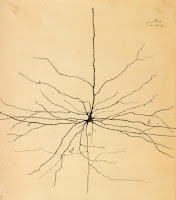 |
Neuroscience has made significant
advances within the modern day medical field. This science is the study of life
and deals with anatomy, physiology, biochemistry, and molecular biology of nerves
and nervous tissues within relation to behavior and learning. With the
invention of the microscope and the discovery of electricity, it was possible
to understand where the brain begins. The brain is not only one of the most
important organs, but the most advanced organ in the human body and is
responsible for controlling your central nervous system such as your conscious
and unconscious thoughts.
 |
| https://machinatorium.files.wordpress.com/2012/08/phreno_01.jpg |
Franz Joseph Gall created the study
of the shape of the skull as a supposed indication of character and mental
abilities, also known as phrenology. Gall was also the first person to discover
grey matter of the brain with active tissue neurons and white matter with
conductive tissue ganglia. Another major contributor to the study of neuroscience
would be Ramon y Cajal. He is the founder of neuroanatomy. Not only is he the
founder neuroanatomy, but a legend with his medical artistry.
 |
Another interesting aspect under
this topic would be the concept of dreams. We have a significant amount of
research about our unconscious mind and dreams, but there is still so much left
as a mystery. Simply remembering and being able to interpret your dreams can be
considered art. Sigmund Freud was one of the first to divide the mind into the
conscious mind and the unconscious mind. Freud believes that dreams provide
valuable clues to how the unconscious mind works.
 |
The process of different sections
of the brain combining to make a whole is art within itself by combining
different elements to result in a working organism, but the idea of
neuroscience delves deeper into the subject of art because humans can actually
create art through our dreams. In our sleep, our mind creates vivid images
consisting of colors and movement that can be random and abstract or have a
specific story line.
Sources:
(Lectures I, II, and III by Victoria Vesna)
Merriam-Webster.
Merriam-Webster, n.d. Web. 10 May 2016.
"Franz Joseph Gall
: Founder of Phrenology." Franz Joseph Gall : Founder of
Phrenology. N.p., n.d. Web. 10 May 2016
"Life and
Discoveries of Santiago Ramón Y Cajal." Life and Discoveries of
Santiago Ramón Y Cajal. N.p.,
n.d. Web. 10 May 2016.
"Dream Moods: Dream
Theories: Sigmund Freud." Dream Moods: Dream Theories:
Sigmund Freud. N.p., n.d. Web.
10 May 2016.
"THE POWER OF
SURRENDER." The Art of Remembering and
Interpreting Dreams. N.p., n.d. Web.
10 May 2016.
Hey! I think its really interesting that you almost equate neuroscience, a facet of the sciences to art given the insight its give humanity as a whole into the mind itself. I agree that the mind is an instrument of art since the mind is the origin of all thought, including artistic thought. I think this speaks to the idea that art and science are actually inextricably linked and this link begins at their origin: the mind.
ReplyDelete